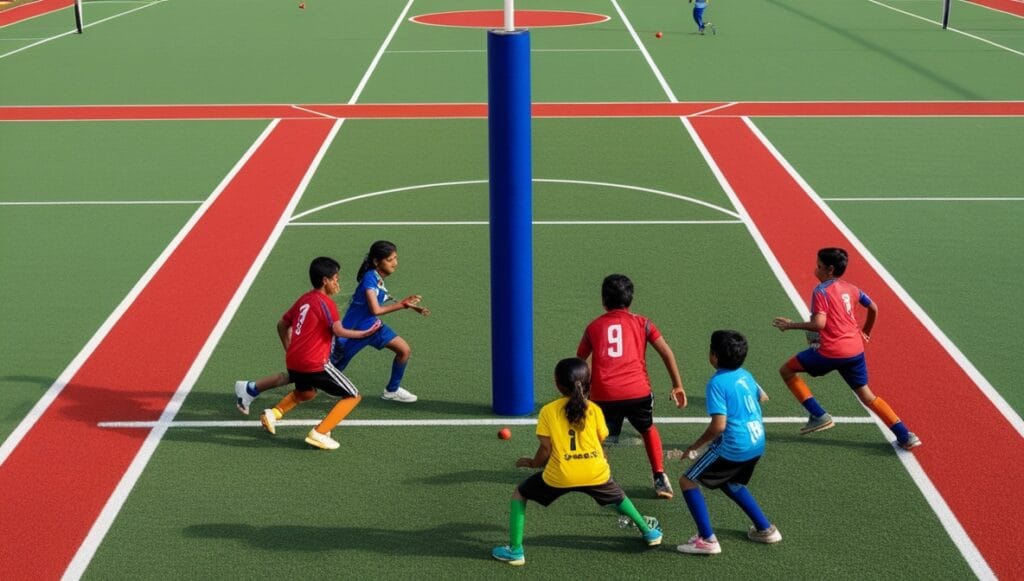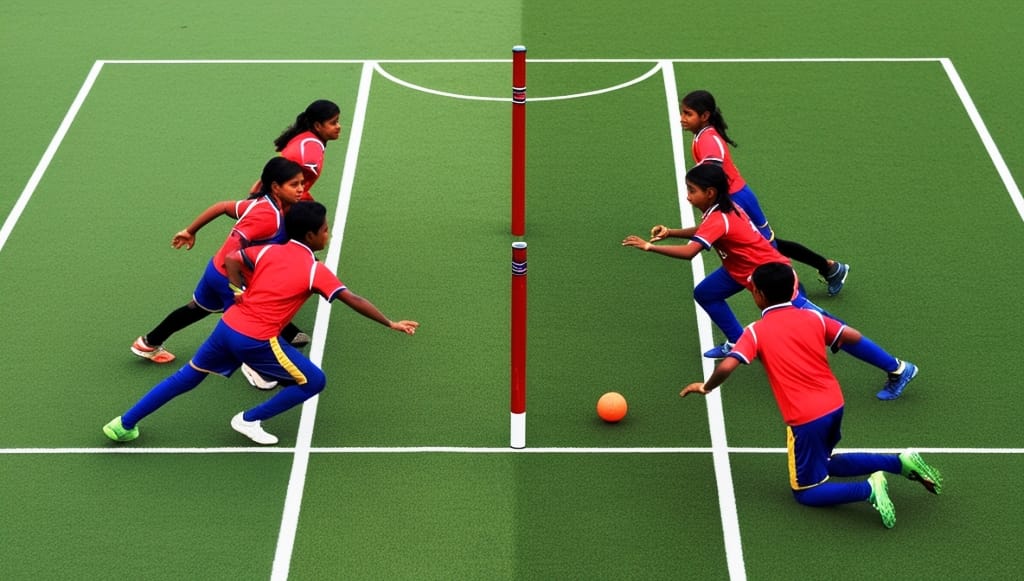Kho Kho, a traditional Indian sport, combines speed, strategy, and teamwork. Understanding its rules is essential for players and enthusiasts alike.
Field Dimensions and Layout
The Kho Kho field is a rectangular arena with standardized measurements based on age groups:
| Category | Length (meters) | Width (meters) | Pole Height (cm) |
|---|---|---|---|
| Senior/Junior (Men/Women) | 27 | 16 | 120–125 |
| Sub-Junior | 23 | 14 | 120–125 |

Two wooden poles (9–10 cm diameter) are positioned at either end, serving as critical markers during gameplay. The central lane, spanning 30 cm wide, divides the field longitudinally.
For insights into how modern technology influences sports infrastructure, explore our analysis of drone technology in field mapping.
Team Composition and Roles
Each team comprises 12 players, with 9 actively participating per turn. Roles alternate between chasing and defending:
- Chasers: Sit in a zigzag formation along the central lane, with one active pursuer.
- Defenders: Enter the field in groups of three, aiming to evade tags.
Substitutions are permitted during intervals, emphasizing squad depth and tactical flexibility.
Match Structure and Timing
A Kho Kho match consists of two innings, each split into chasing and defending turns:
| Phase | Duration | Interval |
|---|---|---|
| Turn | 9 minutes | 3 minutes |
| Innings | 18 minutes | 5 minutes |
Teams swap roles after each turn, ensuring fairness. The clock stops only during substitutions or official timeouts.
Gameplay Mechanics: Chasing vs. Defending
Source: YouTube
- Active Chaser: The lone pursuer must tag defenders or pass the role by touching a teammate’s back and shouting “Kho.”
- Directional Discipline: Chasers cannot reverse direction mid-sprint unless crossing the central lane’s smaller square.
- Pole Utilization: Skilled chasers use poles to corner defenders, a tactic amplified in high-stakes tournaments.
Chasing Team Strategies
Defending Team Tactics
- Evasion Techniques: Defenders employ sudden directional shifts, feints, and sprints to waste time.
- Batch System: Three defenders enter per batch; the next group enters only after all prior defenders are dismissed.
Watch a video demonstration of advanced Kho Kho strategies to visualize these mechanics.
Scoring System
Points are awarded solely for tagging defenders. Each successful tag equals one point. Bonus points (e.g., for all-out batches) may apply in league tournaments. The team with the highest aggregate after four turns wins.
Common Fouls and Penalties
| Foul Type | Penalty |
|---|---|
| Improper “Kho” transfer | Warning or point deduction |
| Centerline violation | Turnover to opposition |
| Obstruction | Immediate dismissal |
Referees issue yellow cards for repeated offenses; red cards result in ejection.
Equipment and Attire
- Poles: Must adhere to specified dimensions for competitive integrity.
- Uniforms: Bright, contrasting colors for team identification.
- Footwear: Lightweight shoes with grip-enhancing soles.
Modern gear innovations, such as moisture-wicking fabrics, are explored in our piece on retail technology trends.
Training and Skill Development
Elite players focus on:
- Speed Drills: 40-meter sprints to boost acceleration.
- Reaction Training: Simulated tag scenarios under timed conditions.
- Team Coordination: Synchronized “Kho” transfers to minimize gaps.
Historical Evolution
Originating in Maharashtra, Kho Kho was formalized in 1914 by Deccan Gymkhana. The first national championship (1960) marked its rise, culminating in its inclusion in the 2023 Asian Games.
Governing Bodies and Tournaments
- KKFI (Kho Kho Federation of India): Oversees national rankings and rules.
- Ultimate Kho Kho League: A franchise-based tournament featuring elite athletes.
Learn how organizations leverage data analytics in our article on AI-driven sports strategies.
For a visual understanding of Kho Kho rules, you might find this video helpful:
Source: YouTube
